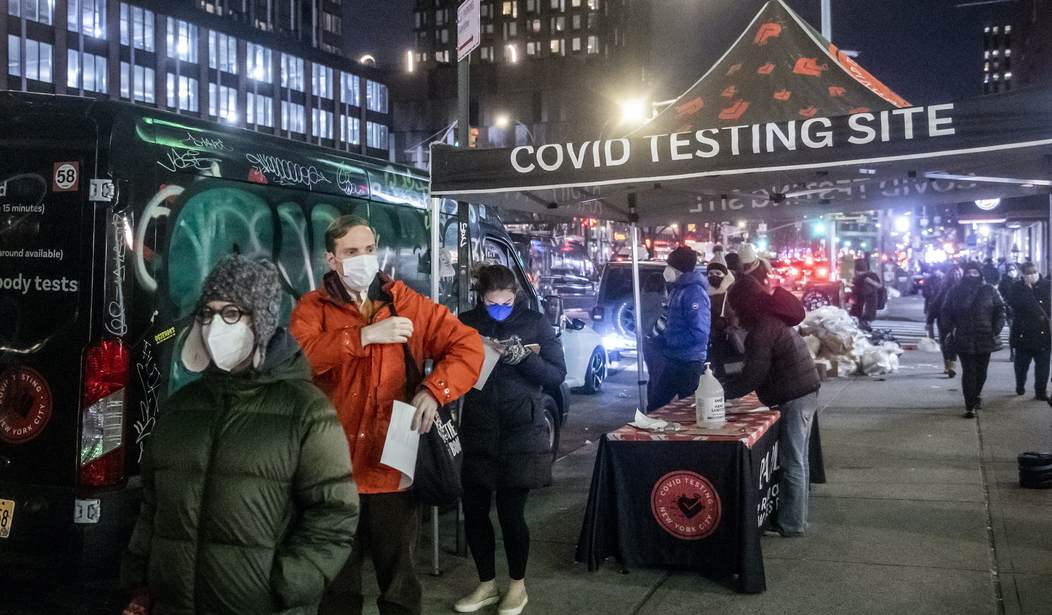I remember writing around New Year’s that although cases in the U.S. were exploding, deaths had actually dropped slightly over the preceding two weeks. That was evidence that the new variant wasn’t just milder than its predecessors but a hopeful sign that it might be supplanting Delta in the population, driving the old variant to extinction.
Maybe deaths would even continue to decline as Omicron spread, producing a bizarre divergence in which case counts skyrocketed while fatalities fell. At last, we’d be transitioning from pandemic COVID to endemic COVID.
Two weeks later, the trend in deaths has changed.

Daily deaths are now 55 percent higher than they were at the start of January, averaging just a shade below 2,000. Since cases in the U.S. have yet to peak, it’s a cinch that we’ll soon surpass the peak of fatalities during last summer’s brutal Delta wave. We’d still have a ways to go before we saw more deaths per day than we did at the peak of the pandemic a year ago, when the U.S. briefly averaged more than 3,000 daily, but there’s no telling where the numbers might end up. Omicron is uncharted territory. Just yesterday, for instance, the country recorded 2,954 deaths.
We’ve already set a new record for daily hospitalizations too:

A lot of those hospitalizations are “with COVID,” not “for COVID,” though, right? Right. But compare and contrast:
The US outlier status for its rise in hospitalizations
—vs European countries now starting descent from Omicron
—in the US, the Omicron wave was superimposed on a 2nd Delta surge
—the US very low 62% vaxx and 23% booster rate is contributing to this @OurWorldInData pic.twitter.com/6LipY4dsQD— Eric Topol (@EricTopol) January 15, 2022
Why is the U.S. seeing so many more people hospitalized during its Omicron wave than European countries are? It’s possible that we’re including “incidental” hospitalizations for COVID in our data more liberally than other western countries are, but I don’t think so. British media has noticed the large number of “incidental” COVID patients in their own hospital data.
Don’t forget either that many “incidental” patients aren’t true “incidentals” in the sense that they’re in the hospital for reasons entirely unrelated to the virus, like for a broken arm. Many have serious underlying illnesses that have been exacerbated by COVID. Those who end up dying of that underlying problem might be said to have died “with COVID” rather than “from COVID” but they probably wouldn’t have been hospitalized in the first place if the virus hadn’t aggravated their condition.
Compare daily deaths recently in the UK to deaths in the U.S. They’ve also seen an uptick in fatalities as Omicron has blazed across the country…

…but, per capita, their numbers are much lower than ours. The U.S. has around five times the UK’s population; multiply the deaths recorded in Britain on January 9 by five and you get 1,140. We saw more than two and a half times as many fatalities as that yesterday.
What gives? Why is America’s Omicron wave more severe than Europe’s?
This isn’t the first time that’s happened, writes David Wallace-Wells. The UK also had a much milder Delta wave than we did as measured by fatalities. The “decoupling” of the case curve from the death curve in an era of widespread immunity has been ongoing over there for many months — but not here. And the early data from Omicron hot spots suggests that it’s not happening with the new variant either:
On Sunday, the Times published an eye-opening group of charts to illustrate the early shape of American mortality during the Omicron surge. Compiling data from New York City, Chicago, and Boston, what they found was — given everything we know about immunity and about Omicron — almost hard to believe. In each case, shifting the graphs by 21 days to account for the typical lag between diagnosis and death showed that the number of deaths was now growing almost precisely in line with case growth. In other words, in this data at least, there was been almost no “decoupling” between cases and deaths at all — to this point, in these places, the Omicron wave appeared on a per-case basis just about as deadly as last winter’s surge, when hardly anyone in the country was vaccinated and the virus itself was inherently more virulent than this variant. In South Africa’s Omicron surge, there was a 30-fold reduction in case-fatality ratio from their previous wave — a decline of more than 95 percent. In Europe, the decoupling hasn’t been quite as dramatic, but in country after country, the divergence in cases and deaths is striking nevertheless. This set of American data suggested declines of just 10 or 20 percent.
That’s based on just three cities, of course, but those cities are all heavily vaccinated and have plenty of natural immunity from prior waves. Yet, even so, fatalities are rising in parallel to rising cases. If that trend were to continue nationally, notes Wallace-Wells, the U.S. might eventually see 5,000 deaths or more per day, far past the record set during the wave of winter 2021. That’s not supposed to happen with a “milder” variant after we’ve spent a year building immunity across the population.
What could explain the comparative severity of America’s Omicron wave relative to Europe’s? There’s no shortage of theories. For starters:
“We have an older population than South Africa. That’s a big one,” [epidemiologist David Larsen] said. “[The US] is kind of similar in age structure to Europe. But there’s also a less healthy population than in Europe.”
As examples, Dr Larsen noted that rates of hypertension and obesity – both of which are comorbidities that increase the risk of Covid – are higher in the US than in most other countries…
“The seasonality is also different,” he said. “Omicron’s surge through South Africa was during their summer, and it’s hitting us in winter when we know more people gather indoors and there’s more transmission…it’s going to be bad.”
It’s also possible that we have more Delta circulating here than abroad and that most of our daily deaths are being caused by the older variant. But if so, why? How did Europe shake off Delta while we continue to struggle with it? And if Delta is still circulating here despite the fact that Omicron represents over 95 percent of new infections, that suggests the more dangerous strain may linger even after Omicron has run its course.
My guess is that many of the deaths happening now are due to Omicron, not Delta, notwithstanding the large body of evidence that the new variant is milder for most people. A tiny fraction of a gigantic number is still a big number, as epidemiologists like to say. A strain that’s somewhat less dangerous but hugely more contagious will eventually find its way to that small percentage of people who are susceptible to dying if infected. That’s been the worry with Omicron since literally day one. It may be playing out now before our eyes.
There’s another obvious possibility for why we’re struggling relative to Europe. We’re undervaccinated compared to them:
The U.S. is 65th in the world in per capita full vaccinations.
Easy explanation: The U.S. has a lot of vaccine deniers.
But, wait.
We're also 41st in booster shots per capita!
So, even among vaccine acceptors, we're still bottom-of-the-OECD barrel in distributing shots.
— Derek Thompson (@DKThomp) January 15, 2022
The UK has administered twice as many boosters per capita as we have. Meanwhile, the most heavily vaccinated country in Europe, Portugal, has crushed its death curve even as its case curve soars:
Omicron meet Portugal, one of the world’s most vaccinated nations. Portugal has vaccinated ~90% of its total population. 🇵🇹
Don’t tell me vaccines don’t work. pic.twitter.com/fxaX0TncQF— Chise 🧬🧫🦠💉 (@sailorrooscout) January 12, 2022
Peak deaths in that country came last winter, topping 300 per day. Yesterday they had 34. It’s worth keeping an eye on where that number finally lands as their Omicron wave plays out.
We need some good news to end this bummer of a post so I’ll leave you with this. Kinsa is tracking the trend in fevers recorded by their smart thermometers as a proxy for the trend in COVID infections. The trend lately in the northeast: Down, down, down.









Join the conversation as a VIP Member